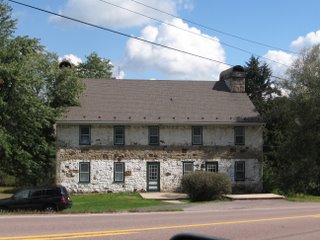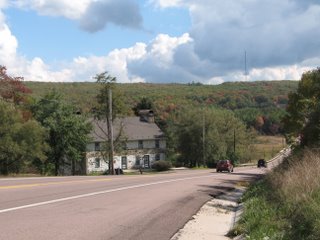
Soon after Sydney and I moved to western Maryland this summer, we discovered scenic U.S. 40 through Garrett County – not the U.S. 40 that shares four lanes with I-68, but Alternate U.S. 40 just north of the interstate, the old National Pike. By far the most striking building on U.S. 40 is this large stone house overlooking Little Meadows, the valley named by George Washington during the 1754 campaign. When we first laid eyes on it, we assumed that it was very old and that it once had been an inn.
Months later, in the marvelous souvenir shop at the Penn Alps restaurant in Grantsville, we picked up a copy of Strange and Unusual True Stories of Garrett County, published by the Garrett County Historical Society. Lo, there was a photo of "the Old Stone House,” built as an inn in 1818 by Jesse Tomlinson, who chose Little Meadows not only for its scenic beauty but for its opportune location on the National Pike about a day’s ride from Cumberland.
Tomlinson’s inn was built to last, of blocks of stone 2 feet and 3 feet square, with chimneys 30 feet wide at the base and 2-foot-deep windowsills. A community center, the inn housed a general store and the county’s first post office. Stagecoach passengers feasted on mutton, venison, turkey, pheasant and brook trout for 50 cents per person; the wagoners, whose trade was essential, got a discount, plus corn whiskey at 3 cents a shot. During their nights of revelry, someone surely sang “The Wagoner’s Lad”:
Your parents don't like me because I am poorAccording to the historical society, celebrated 19th-century guests at the inn included Henry Clay, Jenny Lind, P.T. Barnum and four U.S. presidents: Jackson, Taylor, Polk and President-elect Harrison. But which Harrison? All the other notables named being pre-Civil War, I’m guessing William Henry Harrison – en route from Ohio to his fatal inauguration, maybe?
They say I'm not worthy of entering your door
I work for my living, my money's my own
And if they don't like me, they can leave me alone
Of course, there are ghost stories. One of the bedrooms is said to have a perpetually bloodstained floor. The historical society passes along an even better legend, as it was retold in a 1951 article in Garrett County’s newspaper, The Republican:
The most intriguing story is about a beautiful, heavily veiled woman with quantities of expensive luggage bearing foreign labels, who got off the stage to spend the night at Stone House. She had her supper brought to her room and did not once set foot outside of her door. The next morning one of the little servant boys brought her hot water. But she had disappeared. All of her baggage remained, but there was no trace of her. The woods were searched as thoroughly as possible, but she was never found; and to this day no one knows who she was.From the outside, the building seems to be in good shape. It’s clearly a private residence now, so do respect the residents’ privacy, but if you’d like to drive past this marvelous old building, leave I-68 at Exit 22 and take U.S. 219 north to U.S. 40, then turn right, down the hill toward Frostburg. The Old Stone House is just ahead on your left.
The Republican again, in 1951:
The Old Stone House can still tell many a good tale, but we are too hurried to listen. It sits foursquare in solid strength by the highway and will still be there when we have gone on, clear out of the picture. There is something very sad about its position, still so close to the road it served, but so remote from the present life of that road.


No comments:
Post a Comment